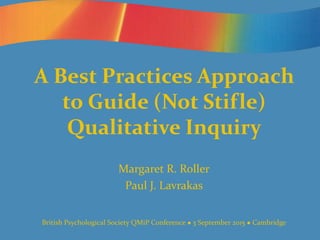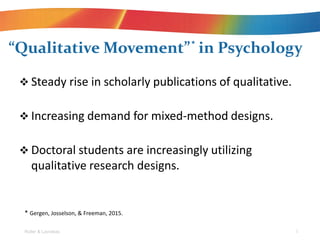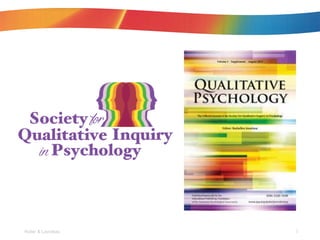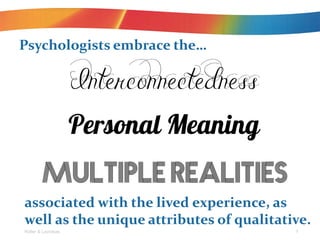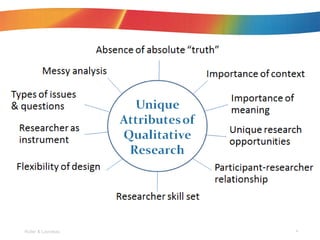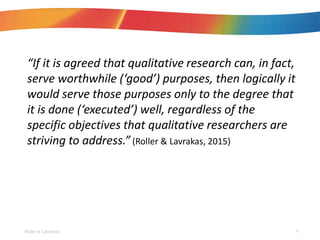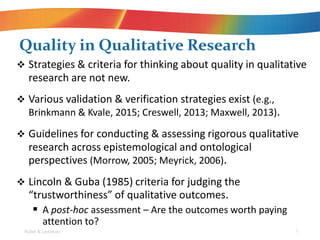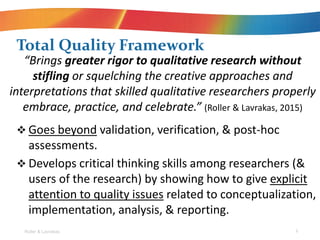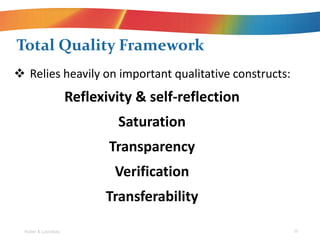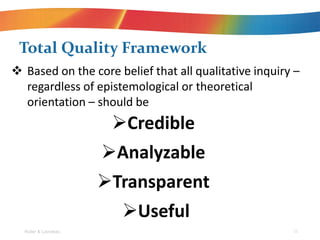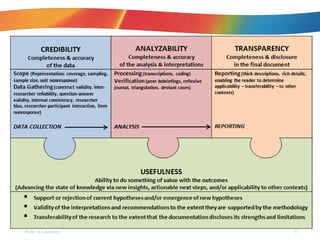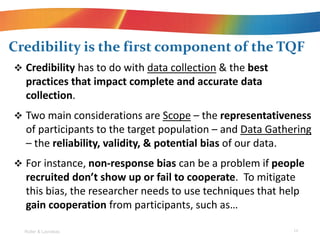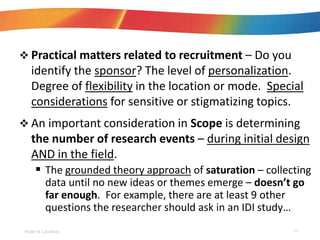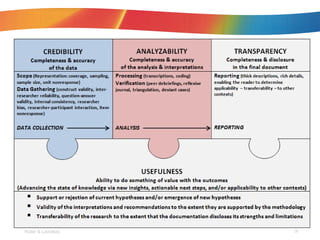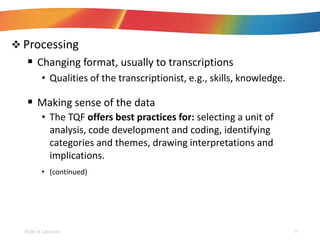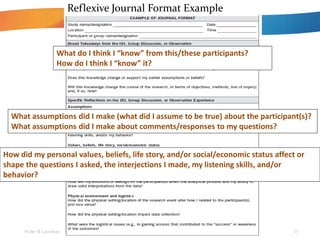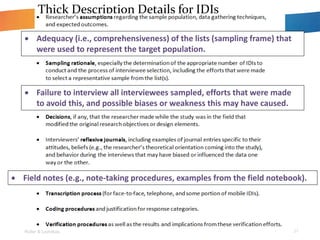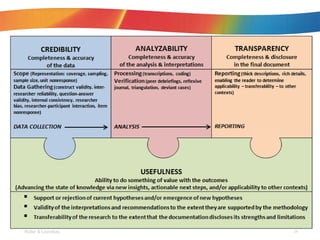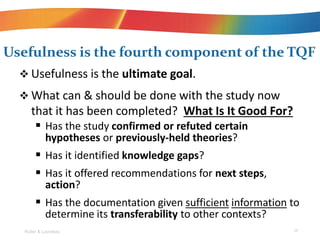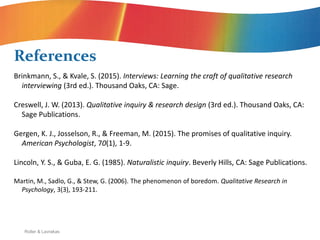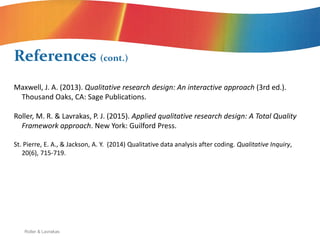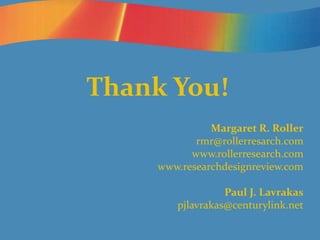A Best Practices Approach to Guide (Not Stifle) Qualitative Inquiry
- 1. A Best Practices Approach to Guide (Not Stifle) Qualitative Inquiry Margaret R. Roller Paul J. Lavrakas British Psychological Society QMiP Conference ● 3 September 2015 ● Cambridge
- 2. ? Steady rise in scholarly publications of qualitative. ? Increasing demand for mixed-method designs. ? Doctoral students are increasingly utilizing qualitative research designs. “Qualitative Movement” in Psychology Roller & Lavrakas 1 * Gergen, Josselson, & Freeman, 2015. *
- 3. Roller & Lavrakas 2
- 4. Roller & Lavrakas 3 Psychologists embrace the… associated with the lived experience, as well as the unique attributes of qualitative.
- 5. Roller & Lavrakas 4
- 6. ? How to weave together the essence of qualitative research & its rich contextual data with quality steps to maximize the usefulness of our research. Unique Attributes Bring Unique Challenges Roller & Lavrakas 5
- 7. “If it is agreed that qualitative research can, in fact, serve worthwhile (‘good’) purposes, then logically it would serve those purposes only to the degree that it is done (‘executed’) well, regardless of the specific objectives that qualitative researchers are striving to address.”(Roller & Lavrakas, 2015) Roller & Lavrakas 6
- 8. ? Strategies & criteria for thinking about quality in qualitative research are not new. ? Various validation & verification strategies exist (e.g., Brinkmann & Kvale, 2015; Creswell, 2013; Maxwell, 2013). ? Guidelines for conducting & assessing rigorous qualitative research across epistemological and ontological perspectives (Morrow, 2005; Meyrick, 2006). ? Lincoln & Guba (1985) criteria for judging the “trustworthiness” of qualitative outcomes. ? A post-hoc assessment – Are the outcomes worth paying attention to? Quality in Qualitative Research Roller & Lavrakas 7
- 9. ? Goes beyond validation, verification, & post-hoc assessments. ? Develops critical thinking skills among researchers (& users of the research) by showing how to give explicit attention to quality issues related to conceptualization, implementation, analysis, & reporting. Total Quality Framework “Brings greater rigor to qualitative research without stifling or squelching the creative approaches and interpretations that skilled qualitative researchers properly embrace, practice, and celebrate.” (Roller & Lavrakas, 2015) Roller & Lavrakas 8
- 10. Total Quality Framework ? Guides the researcher with tools to think about best practices at each stage of the research process regardless of qualitative method. ? Enables users of the research to ask how well the research was conceptualized, implemented, interpreted, & reported. ? Empowers anyone to formulate their own conclusions about the usefulness of the research. ? Not a or but rather a degree of confidence. Roller & Lavrakas 9
- 11. Total Quality Framework Reflexivity & self-reflection Saturation Transparency Verification Transferability Roller & Lavrakas 10 ? Relies heavily on important qualitative constructs:
- 12. Total Quality Framework ?Credible ?Analyzable ?Transparent ?Useful Roller & Lavrakas 11 ? Based on the core belief that all qualitative inquiry – regardless of epistemological or theoretical orientation – should be
- 13. Roller & Lavrakas 12
- 14. Roller & Lavrakas 13
- 15. ? Credibility has to do with data collection & the best practices that impact complete and accurate data collection. ? Two main considerations are Scope – the representativeness of participants to the target population – and Data Gathering – the reliability, validity, & potential bias of our data. ? For instance, non-response bias can be a problem if people recruited don’t show up or fail to cooperate. To mitigate this bias, the researcher needs to use techniques that help gain cooperation from participants, such as… Credibility is the first component of the TQF Roller & Lavrakas 14
- 16. ? Practical matters related to recruitment – Do you identify the sponsor? The level of personalization. Degree of flexibility in the location or mode. Special considerations for sensitive or stigmatizing topics. ? An important consideration in Scope is determining the number of research events – during initial design AND in the field. ? The grounded theory approach of saturation – collecting data until no new ideas or themes emerge – doesn’t go far enough. For example, there are at least 9 other questions the researcher should ask in an IDI study… Roller & Lavrakas 15
- 17. Roller & Lavrakas 16 10 Questions to Evaluate Interview Completions 2. Did all interviewees provide clear, unambiguous answers to key questions or issues, or does the researcher need to go back to some interviewees for clarification? 5. Can the researcher identify the sources for variation and contradictions in the data, and the extent of unexplained differences? 7. Do the data confirm or deny what is already known about the subject matter?
- 18. Roller & Lavrakas 17 ? Also important to Credibility is how information is obtained. A best practice to developing guides is a funnel approach.
- 19. Roller & Lavrakas 18
- 20. ? Analyzability has to do with achieving complete and accurate analysis and interpretation of the data. ? This involves the 2 broad categories of Processing and Verification. Analyzability is the second component of the TQF Roller & Lavrakas 19
- 21. ? Processing ? Changing format, usually to transcriptions ? Qualities of the transcriptionist, e.g., skills, knowledge. ? Making sense of the data ? The TQF offers best practices for: selecting a unit of analysis, code development and coding, identifying categories and themes, drawing interpretations and implications. ? (continued) Roller & Lavrakas 20
- 22. ? Processing ? Making sense of the data ? Computer-assisted qualitative data analysis software (CAQDAS). – Can be useful for organizing & visualizing codes, as well as inter-coder reliability, but it is not sufficient. – “We are concerned about analysis that treats words as brute data waiting to be coded, labeled with other brute words (and even counted)…” (St. Pierre & Jackson, 2014) – It is the human brain, not CAQDAS, that is needed to identify latent meaning & contextual nuances in qualitative data. Roller & Lavrakas 21
- 23. ? Verification ? Add meaning & depth to the data to better inform researcher’s interpretations & implications. ? Evidence to support &/or refute findings. ? Types: ? Peer debriefings ? Triangulation ? Deviant cases ? Reflexive journal – The reflexive journal chronicles the researcher’s assumptions, values, & beliefs, and forces the researcher to reflect on his/her knowledge… Roller & Lavrakas 22
- 24. Roller & Lavrakas 23 What do I think I “know” from this/these participants? How do I think I “know” it? What assumptions did I make (what did I assume to be true) about the participant(s)? What assumptions did I make about comments/responses to my questions? How did my personal values, beliefs, life story, and/or social/economic status affect or shape the questions I asked, the interjections I made, my listening skills, and/or behavior? Reflexive Journal Format Example
- 25. Roller & Lavrakas 24
- 26. ? Transparency is concerned with the final document – its completeness & how well it discloses details of the study. ? “In order for the outcomes of qualitative research to be valued, the strategies used must be transparent and open to scrutiny.” (Martin, Sadlo, & Stew, 2006) Transparency is the third component of the TQF Roller & Lavrakas 25
- 27. ?The goal is to provide the user or reader of the document with sufficient information to: judge the strengths & limitations of the research, evaluate his/her confidence in the outcomes, & determine the applicability of the research to other contexts, i.e., the transferability. ?The focus in Transparency is on the rich details and content provided by way of Thick Description. ?For example, a thick description of an IDI study should include the… Roller & Lavrakas 26
- 28. Roller & Lavrakas 27 Thick Description Details for IDIs ? Adequacy (i.e., comprehensiveness) of the lists (sampling frame) that were used to represent the target population. ? Failure to interview all interviewees sampled, efforts that were made to avoid this, and possible biases or weakness this may have caused. ? Field notes (e.g., note-taking procedures, examples from the field notebook).
- 29. Roller & Lavrakas 28
- 30. ? Usefulness is the ultimate goal. ? What can & should be done with the study now that it has been completed? What Is It Good For? ? Has the study confirmed or refuted certain hypotheses or previously-held theories? ? Has it identified knowledge gaps? ? Has it offered recommendations for next steps, action? ? Has the documentation given sufficient information to determine its transferability to other contexts? Usefulness is the fourth component of the TQF Roller & Lavrakas 29
- 31. Roller & Lavrakas 30 ? Qualitative psychology requires an approach that brings greater rigor to research design without stifling the essence of qualitative inquiry. ? The Total Quality Framework (TQF) uniquely guides the researcher by way of best practices at each research phase. ? Central to the TQF is that all qualitative research must be credible, analyzable, transparent, & ultimately useful. ? TQF best practices lead to more rigorous & better quality research, enables users of the research to evaluate their confidence in the outcomes, & aids in writing and reviewing dissertations, proposals, & manuscripts. Summary
- 32. Roller & Lavrakas Brinkmann, S., & Kvale, S. (2015). Interviews: Learning the craft of qualitative research interviewing (3rd ed.). Thousand Oaks, CA: Sage. Creswell, J. W. (2013). Qualitative inquiry & research design (3rd ed.). Thousand Oaks, CA: Sage Publications. Gergen, K. J., Josselson, R., & Freeman, M. (2015). The promises of qualitative inquiry. American Psychologist, 70(1), 1-9. Lincoln, Y. S., & Guba, E. G. (1985). Naturalistic inquiry. Beverly Hills, CA: Sage Publications. Martin, M., Sadlo, G., & Stew, G. (2006). The phenomenon of boredom. Qualitative Research in Psychology, 3(3), 193-211. References
- 33. Roller & Lavrakas Maxwell, J. A. (2013). Qualitative research design: An interactive approach (3rd ed.). Thousand Oaks, CA: Sage Publications. Roller, M. R. & Lavrakas, P. J. (2015). Applied qualitative research design: A Total Quality Framework approach. New York: Guilford Press. St. Pierre, E. A., & Jackson, A. Y. (2014) Qualitative data analysis after coding. Qualitative Inquiry, 20(6), 715-719. References (cont.)
- 34. Thank You! Margaret R. Roller rmr@rollerresarch.com www.rollerresearch.com www.researchdesignreview.com Paul J. Lavrakas pjlavrakas@centurylink.net

